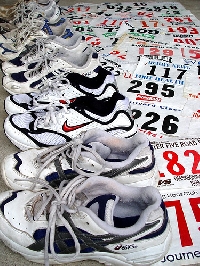
Choosing running shoes for perfect fit and comfort from the many athletic shoes
When choosing running shoes, there can be a myriad of options for the perplexed buyer. Size, style, brand, and — wait, what? — pronation, overpronation, and supination (or under-pronation). These last examples are characteristics of the way we run as it pertains to our feet.
The act of buying a new shoe comes down more to the way we move and the shape of one’s feet than it does the name brand or fancy gimmicks offered by companies. Thus, the proper footwear can mean all the difference in the world; it can lessen/curtail injuries, give the wearer a great outdoors experience, and provide the comfort necessary to push through those barriers to move toward that perfect run.
For Starters
It’s important to not go for the cheapest model available as this can result in more “pain” than gain. Now, think on how you will be using your new purchases: Will you be exercising on trails mostly? Or pounding the concrete in the city? Depending upon your answer, you may buy:
~
- Road running shoes: For those stuck in the city, these ‘ol standbys will do the job. You’ll be able to pound the concrete thanks to the cushioning effect of the brand; they’re light, flexible, and made to stabilize one’s feet during the slog over hard ground.
- Trail running shoes: Those looking to conquer those rocky, grainy, and uneven off-road routes will look to this beefed up foot gear. You’ll get more traction and stability where you need it the most.
Foot Size
It’s always a good idea to have your feet measured at the retail store. As well, the best option is to try on your new pair of kicks and take them for a test walk or run to test the initial feel of comfort.
According to research, most women will wear a B-width shoe; many men will look to D-width footwear. Men and women don’t need to stay in gender specific footwear, either. Men with more narrow feet can look to the women’s foot gear while women who posses slightly larger (or wider) feet can try the male variety.
Arch Shape and the Biomechanical Tendencies
When you step out of the shower or bath, take a look at the imprint your wet foot makes on the rug or linoleum. By doing this, you can tell your arch shape, whether it be high, normal, or flat-footed. There are other ways to do this, as well, such as wetting the bottom of your feet and then standing upon a paper bag for a minute. But:
- High arch: There will be a very narrow, curved footprint
- Normal arch: This print will fall in-between the flat-foot and the high arch
- Flat-footed: You’ll see a wider and straighter print, which means a lower arch
One’s foot shape is very closely related to how you run. And how you run relates to the best type of shoe for you. Thus, let’s give an example of what we were talking about in the beginning paragraph:
- Pronation: This is known as the rolling of one’s foot from heel to toe through the foot strike. Or, better put, it’s the natural inward roll directly following one’s heel striking the surface. Neutral (or proper) pronation allows for better absorption of impact and thus relieves pressure on both joints and knees during exercise. It occurs when your foot hits evenly on the surface, from the heel to the ball of your foot.
- Overpronation: Basically, this is too much roll from the outside to the inside of your foot as you move.
- Supination (or under-pronation): Not too many runners suffer from supination, but for those who do, it involves an outward rolling of the foot.
For those suffering from overpronation, stability (help lessen basic pronation) or motion control foot gear (counter overpronation) will be the best option for them. Cushioning footwear will work for both mild pronators or supinators, as well.
Thus, when choosing running shoes it’s more about shape and form than brand name or style. In the end, being knowledgeable about these characteristics can make you a better runner and a more comfortable one at that. For more information, head over to The Running Advisor to learn more.
Resources:
The Running Advisor: How to Choose A Running Shoe.
Above photo attributed to Andy_Myers_Esq

